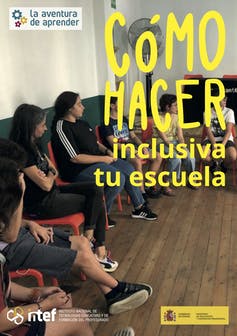The experiences of ordinary people in the educational system can constitute forms of valuable social research. In the course of our research on inclusion in school, we are concerned (ba) to know whether in the educational system of our country there is room for all boys and girls. From everything we heard, we were especially captivated by what the students told us. Although it is hardly heard for the transformation of policies and practices, the voice of the students seems fundamental to make radical inclusive proposals.
To enable a commitment to respect human diversity through dialogue, we wanted to have students who are very different from each other and to be able to have a good representation of the diversity of our society. We paid special attention to the most vulnerable, who are often silenced and excluded in schools. The way of proceeding had to provoke the participation of each one of the members. The group would not make sense if we did not get everyone to feel an important part of it. In other words, the methodology had to be inclusive.
We formed our group with 16 young people between 12 and 19 years old willing to help other students to improve their own schools. We had a challenge ahead: to create a guide to make schools inclusive places. A work designed by students and aimed at students. Who better than them to know what the school really needs?
Shared experiences
This is how we began to analyze the educational system, always from their experiences so generously shared with the group. It was personal dedication to social construction: the experience of each one at the service of the common good. They were reviewing issues, approaching them from the emotions, sharing joys and miseries, readings and proposals, knowledge, ignorance and uncertainties.
>
They taught us the limits of what is allowed to think, what is legitimate to pose and what is a sin to imagine. Through their stories, we get a glimpse of realities that live poorly in the school of meritocracy, where those who have the ability to expose their functioning are hidden, withdrawn and expelled.
Barriers and loneliness
During those meetings, no one had to talk about the category by which they encountered barriers at school. No one spoke of anything particular that made him different from the rest. It was not necessary. They just were. No one was more than anyone, and yet everyone was better with each other. And that didn’t need to be explained to them either, they learned it by being together. It can be said that an inclusive group was constituted, generated by its heterogeneity, but also by the way in which relationships were built within it.
The meetings were getting more and more interesting. From the protagonists, the themes in which they considered that the school had to improve emerged: the loneliness that someone had faced, marginalization, segregation, the burden of duties, the evaluation system used, punishments, the meaning of exams, the incompatibility of being sick and being a student, or boredom.
Hear their own voices
For our part, and as researchers, the task was to let ourselves be carried away by their speeches and debates, generating from them proposals for the following sessions. The analysis of each meeting allowed us to review the different aspects that constitute the policies, cultures and practices of their schools, the social relations and the way in which the teaching-learning processes are organized. Knowing that there was a research team listening carefully to what they were saying offered a certain value to the group’s work, while at the same time giving them greater security in themselves and in others.
Every week we were collecting their ideas and making categorizations that would help them design proposals for the next meeting. We were thus trying to facilitate conversations in which girls and boys were unknowingly becoming the principal investigators.
In this way, when the conversations showed that they were reaching saturation, we ended the meetings. So we invited them to analyze what they had said during all those meetings that had been recorded on video. By that time, his words, which had been ignored so many times in their schools, had become the text to study.
They were learning to recognize and value themselves by beginning to place problems in the barriers that their schools put up for them, and not in their own bodies. This, together with becoming aware that they are not alone and that they have the capacity to decide on their realities, constitutes the main achievement of the process followed.

CC BY-SA
A simple and practical guide
Thus was born How to make your school inclusive, a work in which a step-by-step guide is offered to analyze reality, create proposals and put them into practice. It is a Youth Participatory Action Research. In this document, the work of boys and girls is related to the international scientific evidence on inclusive education.
The result is a very simple and practical text, which makes dialogue and participation its greatest tool. These students, often invisible in their schools, have already begun to transform the system.
Luz del Valle Mojtar Mendieta, Professor of the Department of Theory and History of Education and MIDE, Malaga University; Florencio Cabello Fernández-Delgado, Professor of the Department of Audiovisual Communication and Advertising, Malaga University and Ignacio Calderon Almendros, Professor of the Department of Theory and History of Education and MIDE, University of Malaga
This article was originally published on The Conversation. read the original.
Reference-www.eleconomista.com.mx